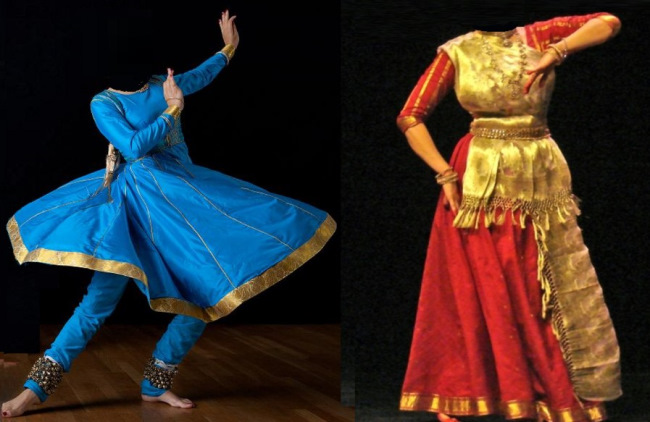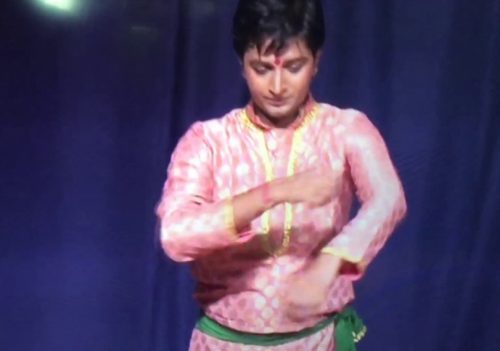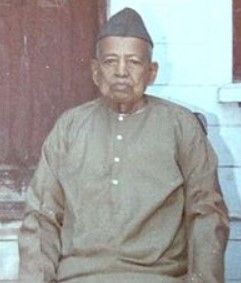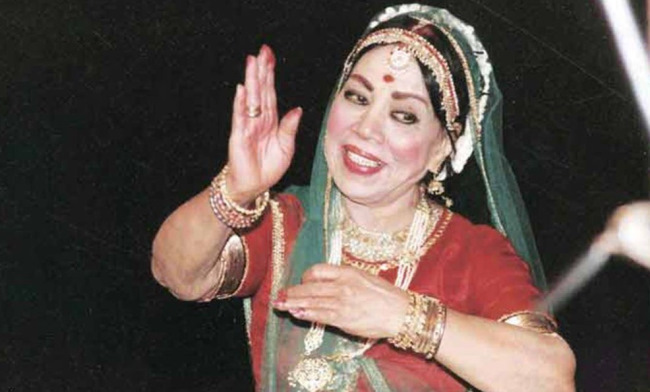India is a land that is known for its vibrant culture. Among the many cultural staples of India is the Kathak dance. It is one of eight “classical” (or “traditional”) Indian dances.
If you want to discover more about the country, its culture, and its people, then learning about Kathak is a great way to do so.
This guide contains everything you need to know about the Kathak dance, from its history and costumes to the most famous dancers you should watch!
Table of Contents
What Is Kathak Dance?
The name “Kathak” was derived from the Vedas (an ancient Indian religious text similar to the Bible), which means “conversation”, “story”, or “traditional tale”.
And indeed, the Kathak dance isn’t just dancing for dancing’s sake. Each performance tells a story.
Typically, the stories told by the Kathakars (the traveling bards that perform Kathak) are classic Indian legends and epics. The most famous and often-told tales are about the life of Lord Krishna – a major deity in Hinduism.
The story isn’t told by words. It’s all in the movements of the dancers.
Each detail of the story is told through the dancers’ rhythmic foot movements, their fluid upper body moves, hand gestures, and their facial expressions.
In the present day, Kathak has gone through many changes. There are now three distinct styles of this dance: Classical, Contemporary, and Sufi. We will discuss each style in later sections.
Kathak Dance Origin
How it started
Like most traditional dances, it is very hard to pinpoint exactly when, where, and by whom Kathak was created.
But according to most sources, the earliest record of Kathak was the “Natya Shastra”. It’s an ancient Hindu performing arts text dated from 200 BCE to 200 CE.
Some sources disputed the timeline, putting the text’s appearance between 500 BCE and 500 CE.
The text’s author was Bharata Muni, an ancient sage who’s considered to be the father of Indian theatrical arts and music.
There are 6,000 verses in Natya Shastra, divided into 36 chapters.
Each chapter is devoted to a specific topic, like postures, acting methods, dance gestures, basic steps, and discussions on rasa and bhava (Indian philosophical concepts about the beauty and aesthetic of the arts).
Some dance forms recorded in the texts have been found to match those within Kathak.
In the 2nd century BC, the word “Katha” appeared in the Vendas, eventually becoming the dance’s name. As a dance form, Kathak was presumed to have first appeared in the Banaras or Varanasi region to the north of India.
Then, it began to spread throughout the north and northwest areas of the country to Jaipur and Lucknow.
The Bhakti movement era
The Bhakti movement was a major religious reform in ancient India. During this era, the Lucknow Gharana of Kathak was formed by Ishwari Prasad, a devoted follower of the movement.
It’s believed that he was visited by the god Krishna in his dream and was commanded to develop “dance as a form of worship.”
And the result of that dance was Kathak.
The Lucknow Gharana of Kathak was basically a musical “guild”. It united all the musicians and dancers of Kathak.
The organization was also a tool to pass the knowledge and techniques of Kathak from generation to generation.
And, indeed, Ishwari passed the knowledge of the dance to his sons, who continued to pass it down to their children.
Kathak was handed down through more than six generations! It’s how so much about it is still known today.
During the Bhakti era, Kathak mostly tells stories about Krishna and his love for Radhika (his chief consort). Stories were usually adapted from texts like the Bhagavata Purana.
The Mughal era
In the Mughal era, Kathak underwent a drastic transformation. From a type of religious dance, it was converted into an entertainment dance usually performed in royal courts.
Records told of it being used as an aristocratic entertainment form, with the actors, actresses, and musicians coming from low-income families.
During this era, the very nature of Kathak was changed, too. Many Persian and Central Asian elements are incorporated into the dance. Whirls were incorporated into the repertoire, similar to Sufi dances.
Saris were replaced by costumes that bare the mid-riffs of the dancers. Female dancers also wear transparent veils, like those of Harem dancers in medieval times.
British Raj era
Kathak was discouraged, along with most traditional Indian art forms during the colonial era (also known as the “British Raj era”).
The British were quite successful in discouraging Kathak by stigmatizing the dancers. Christian missionaries and British officials held great contempt for Kathak dancers, likening them to harlots.
Instead of letting people practice Kathak and Hinduism, missionaries and British officials tried hard to purge all traces of them from the fabric of Indian society. European arts and religions are put in their places.
Evidence of the stigmatization of Kathak can still be viewed today.
The 1900 book by Marcus B. Fuller called “The Wrongs of Indian Womanhood”, for example, contains caricatures of the facial expressions of female Kathak dancers.
But dancers weren’t just ridiculed, they were also financially pressured to give up the trades by the government.
This led to an unfortunate decline in Kathak.
Revival (Post-Independence era)
But even such heavy-handed actions didn’t kill Kathak completely.
After India gained its independence from Britain in 1947, Indians began the long and hard work of reviving their cultures. One of which was to reinstate Kathak as a respectable dance.
This movement gained traction not just in the Hindu communities, but also among Muslims.
Around the 20th century, Kathak began to appear on the international stage and gained a global viewership. This was due to the effort of Kalkaprasad Maharaj, a famous Kathak dancer.
3 Kathak Dance Gharanas
There are three “Gharanas” (guilds, schools) of Kathak: Jaipur, Benares, and Lucknow.
All of them practice Kathak, but they differ in minor details. Each school emphasizes different dance elements, like footwork or spiritualism.
We’ll discuss this more as we delve deep into each Gharana below.
The Jaipur Gharana
The Jaipur gharana is known for its spiritualism-centric performances. It traces its origin back to Bhanuji, a famed dancer.
After he visited the city of Vrindavan, he was inspired. He took up Natvari Nritya, a dance known as the “Dance of Krishna” closely associated with Kathak.
Not just Bhanuji but his grandsons Laluji and Kanhuji were also inspired. After their trip, they returned to Jaipur, where they started the Jaipur Gharana of Kathak.
The styling of this gharana is highly religious and spiritual, incorporating many themes from Hinduism.
Additionally, it’s also known for its innovations in rhythmic dancing with its footwork and dance routines.
The Benares Gharana
This is believed to be the oldest gharana out there. Much of its history is unknown, but according to one source, the Benares gharana originated from a village near the northwestern Indian city of Bikaner.
It was started by Janakiprasad, a dancer and scholar whose ancestors were famous musicians and dancers.
He’s believed to be the one behind the bols of Kathak, which were mnemonic syllables used in the language of this dance.
The Lucknow Gharana
We have touched on the origin of the Lucknow gharana in the Bhakti movement era section above. The school started with Ishwari Prasad and then continued with his children.
The Lucknow style puts heavy emphasis on the acting and entertaining part of Kathak, harkening back to the court-style transformation of the dance during the Mughal era.
It’s a pretty ironic twist, really. While the Lucknow Gharana was started as a purely spiritual dance school, it has now adopted a more modern approach to the dance.
Meanwhile, the religious aspect has been mostly relegated to the Jaipur gharana.
The Pure Dance And The Expressive Dance
The Pure dance (Nritta) and the Expressive dance (Nritya) are two parts of a Kathak performance. No matter what gharana is performing, you will see both of these elements in their routine.
The Pure Dance (Nritta)
Nritta represents the abstract, fast-paced, and rhythmic aspect of the dance. It is called the “pure” dance because, in this segment, the viewers are treated to pure movement.
The emphasis is placed not on the expression or the tale behind the story, but on the technical work of the dancer.
It starts with a short sequence called thàth, which includes slow, graceful movements of the neck, the wrists, and the eyebrows.
Then, the dance will gradually pick up the pace, increasing in energy and speed, while also performing a sequence of bol (mnemonic syllables in Indian dance).
Each bol includes a series of moves ranging from footwork to gestures and turns. The bol ends with a sharp turn of the head similar to a punctuation mark in a sentence.
The Expressive dance (Nritya)
In the Nritya, the dance is slower. The aim is no longer to show off the technical mastery of the dancer.
Rather, it’s to express emotions and tell the story behind the performance in line with traditional Hindu legends.
It does so by incorporating words, musical notes, and gestures into the dance. It stimulates not just the vision of the viewers, but also their hearts and minds.
Kathak Dance Costume
Costumes vary from dancer to dancer, as well as the gharana. They can take inspiration from both Hindu and Muslim cultures.
Hindu costumes
In Hindu-inspired costumes, there are two versions for female dancers.
The first one is based on the Sari, but unlike the traditional style, the Kathak costume is wrapped around the waist and allowed to hang from the left shoulder.
The upper body is covered up by a piece of clothing known as the choli. They can wear scarves and their bodies are usually adorned with jewelry.
A bindi – a colored dot in the middle of the forehead – is also one of the most popular Kathak dance accessories.
The second version of the Hindu Kathak dance attire involves a long, ankle-length embroidered skirt. A choli in contrasting colors is worn for the top.
As for male dancers, they will wear a silk dhoti around the waist. A silk scarf is tied over the top. The top of the body is usually left bare, or only loosely clothed in Hindu thread or a sleeveless jacket.
Jewelry can also be worn, but they are usually made from stones and are simpler than the jewelry worn by female artists.
Muslim costumes
For female dancers, the costume involves a skirt and a churidar (a type of tight-fitting trousers). A long coat is typically worn to cover the top portion of the body and the hands.
They will wear a light scarf on their head, and the jewelry is generally light.
Male dancers wear the kurta-churidar kathak dance dress, which is a Mughal costume.
Kathak Dance Music & Instruments
A single Kathak dance can have the backing of up to a dozen musicians and instruments, depending on the musical effect required by the performance.
Certain instruments, like the tabla, are always present. The tabla is a pair of hand drums that harmonizes very well with the rhythmic foot movements of the dancers.
The sarangi, harmonium, and manjira (a type of hand cymbals) are also used to measure the tal (cycle) of the dance. Other instruments can make appearances from time to time.
As for the music, Kathak is usually danced to the tunes of Dhrupad, an ancient genre of Indian music.
Check more: Bhangra Dance: History, Costumes, Moves, Music & More
Notable Kathak Dancers
Pandit Birju Maharaj
Pandit Birju Maharaj, born in 1938, was a famous dancer and exponent of the Lucknow Gharana of Kathak. He has been dancing since he was four, trained by his uncles and father.
Pandit made his debut appearance at age seven in West Bengal, and began to teach people the art of Kathak when he turned 13.
His influence was great not just in Kathak, but also in Indian music as a whole. A singer, composer, and choreographer, he handled the choreography and music of many famous movies.
For his works, he received the Sangeet Natak Akademi Award, becoming one of the youngest artists to receive this honor at age 28.
In 1986, he also received the Padma Vibhushan, India’s second-highest civilian award.
He recently passed away on January 16th, 2022.
Janaki Prasad Gharana
Janaki Prasad Gharana was the person that the Benaras (or Benares) gharana was named after. We have briefly introduced him in the section about the Benares Gharana above.
He came from the village of Mailsur in the Bikaner state of India, and all of his ancestors were famous dancers and musicians.
A passionate exponent of Kathak and a Sanskrit scholar, he devised the bols, the mnemonic syllables of dance that are still used today in Kathak.
Ishwari Prasad
Ishwari Prasad was the founding father of the Lucknow gharana.
Legends told that he was visited by Krishna in a dream and told to establish a religious dance form. And so he did, resulting in the creation of the Lucknow gharana.
He continued to teach and spread the dance until he was 100 years old.
Today, his children and descendants continue the tradition, passing down the knowledge of Kathak and its philosophy from one generation to another.
Sitara Devi
Sitara Devi (born 1920) was a classical Kathak dancer who’s considered by many to be the Kathak Queen.
Her birth name was Bhanalakshmi, a homage to the goddess of good fortune Dhanlakshmi, since she was born during the Dhanteras festival. Hindus worship Dhanlakshmi during the festival.
Both of her parents were performing artists. Their passion for dancing was passed down to her. Her father – Sukhdev Maharaj – taught her how to dance when she was young.
When she was a teenager, Devi met the famous polymath Rabindranath Tagore, who encouraged her to revive the traditional arts of India like Kathak.
When he watched her performance when she was sixteen, he bestowed upon her the Kathak Queen title (Nritya Samragni, नृत्य सम्राज्ञी).
Today, she’s still known as the Kathak Queen by most of her fans and followers.
Sitara Devi passed away on November 25th, 2014 at age 94.
Final Words
And that’s all of the essential information on the Kathak dance that you should know if you’re interested in this wonderful kind of traditional performance art.
India’s culture is rich and vibrant. We hope this article has aroused your interest in the country’s culture, people, and most importantly, its dances!





